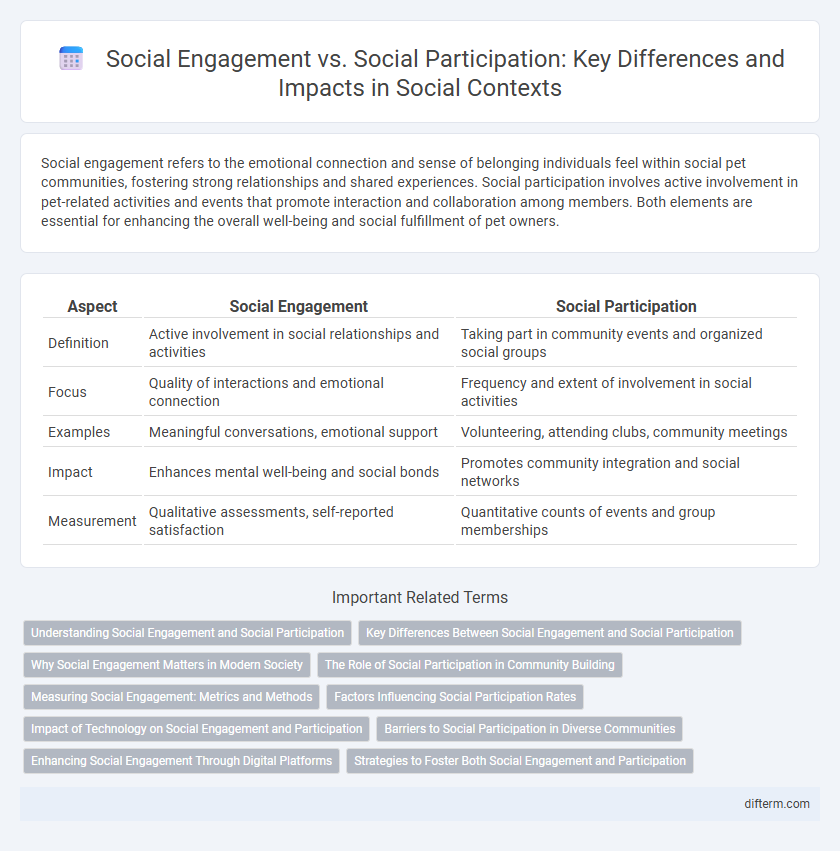Social engagement refers to the emotional connection and sense of belonging individuals feel within social pet communities, fostering strong relationships and shared experiences. Social participation involves active involvement in pet-related activities and events that promote interaction and collaboration among members. Both elements are essential for enhancing the overall well-being and social fulfillment of pet owners.
Table of Comparison
| Aspect | Social Engagement | Social Participation |
|---|---|---|
| Definition | Active involvement in social relationships and activities | Taking part in community events and organized social groups |
| Focus | Quality of interactions and emotional connection | Frequency and extent of involvement in social activities |
| Examples | Meaningful conversations, emotional support | Volunteering, attending clubs, community meetings |
| Impact | Enhances mental well-being and social bonds | Promotes community integration and social networks |
| Measurement | Qualitative assessments, self-reported satisfaction | Quantitative counts of events and group memberships |
Understanding Social Engagement and Social Participation
Social engagement refers to the quality and frequency of interactions individuals have within their social networks, emphasizing emotional connections and meaningful communication. Social participation involves active involvement in community activities, organizations, or civic responsibilities that contribute to societal functioning and personal well-being. Understanding these concepts highlights their distinct roles in enhancing mental health, fostering social support, and promoting inclusive communities.
Key Differences Between Social Engagement and Social Participation
Social engagement refers to the quality of connections and interactions individuals have within their community, emphasizing emotional involvement and meaningful relationships. Social participation involves active involvement in group activities, community events, or social roles, highlighting frequency and presence in social settings. Key differences lie in social engagement focusing on emotional bonds and cognitive involvement, while social participation centers on behavioral aspects and active membership in social groups.
Why Social Engagement Matters in Modern Society
Social engagement fosters meaningful connections and strengthens community bonds, enhancing overall well-being and social cohesion. Increased social participation leads to greater empowerment and active citizenship, contributing to democratic processes and social justice. Understanding why social engagement matters helps address issues like loneliness, mental health, and societal disparities in modern society.
The Role of Social Participation in Community Building
Social participation fosters active involvement in community activities, strengthening social bonds and collective identity. It enhances social cohesion by encouraging diverse groups to collaborate, share resources, and support common goals. Increased social participation leads to resilient communities with improved well-being and a robust sense of belonging.
Measuring Social Engagement: Metrics and Methods
Measuring social engagement involves tracking metrics such as frequency of interactions, duration of participation, and quality of communication within digital or physical communities. Tools like surveys, social media analytics, and behavioral data analysis quantify engagement by assessing user activity, emotional connection, and contribution levels. Employing both qualitative and quantitative methods ensures a comprehensive evaluation of social engagement beyond mere social participation counts.
Factors Influencing Social Participation Rates
Social participation rates are influenced by factors including socioeconomic status, age, cultural background, and access to community resources. Higher education levels and stable income correlate with increased engagement in social activities, while barriers such as social isolation and limited transportation reduce participation. Community support systems and inclusive policies significantly enhance opportunities for diverse populations to engage meaningfully in social networks.
Impact of Technology on Social Engagement and Participation
Technology significantly enhances social engagement by enabling real-time communication through social media platforms, virtual communities, and interactive apps, fostering connections across diverse demographics. Social participation is increasingly facilitated by online forums, digital activism, and virtual events, broadening access to civic activities regardless of geographic limitations. The integration of AI-driven algorithms personalizes content delivery, boosting user interaction and sustained involvement in social causes and community initiatives.
Barriers to Social Participation in Diverse Communities
Barriers to social participation in diverse communities often include language differences, cultural misunderstandings, and limited access to resources such as transportation and technology. Social engagement is hindered when individuals face discrimination, lack of inclusive programs, or inadequate support networks that fail to address their unique needs. Overcoming these obstacles requires targeted policies that promote equity, cultural competence, and community-driven initiatives fostering meaningful involvement.
Enhancing Social Engagement Through Digital Platforms
Digital platforms significantly enhance social engagement by enabling real-time interaction, community building, and access to diverse social networks. Social engagement on these platforms fosters meaningful connections through personalized content, interactive features, and user-driven collaboration. Increased engagement leads to higher participation rates, amplifying the collective impact of social initiatives and strengthening community bonds.
Strategies to Foster Both Social Engagement and Participation
Developing inclusive community programs that encourage diverse age groups and backgrounds can significantly enhance social engagement and social participation. Utilizing digital platforms alongside in-person events creates accessible opportunities for connection and collaboration, promoting sustained involvement. Providing educational workshops and volunteering initiatives cultivates a sense of belonging and active contribution, strengthening overall social cohesion.
social engagement vs social participation Infographic

 difterm.com
difterm.com